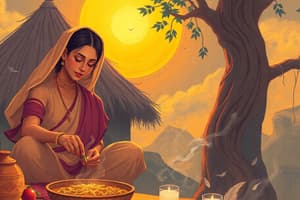Podcast
Questions and Answers
What is the official language of Bangladesh?
What is the official language of Bangladesh?
- Punjabi
- Bengali (correct)
- Hindi
- Urdu
Which notable figure is known as the first non-European Nobel laureate in Literature?
Which notable figure is known as the first non-European Nobel laureate in Literature?
- Sukanta Bhattacharya
- Bengali Sahitya Akademi
- Kazi Nazrul Islam
- Rabindranath Tagore (correct)
Which festival marks the Bengali New Year?
Which festival marks the Bengali New Year?
- Holi
- Durga Puja
- Eid
- Pohela Boishakh (correct)
What is a staple food commonly found in Bengali cuisine?
What is a staple food commonly found in Bengali cuisine?
What is the typical word order followed in Bengali syntax?
What is the typical word order followed in Bengali syntax?
Flashcards are hidden until you start studying
Study Notes
Language
- Bengali (বাংলা) is an Indo-Aryan language.
- Official language of Bangladesh and the Indian state of West Bengal.
- Spoken by over 230 million people, making it one of the most spoken languages in the world.
- Uses the Bengali script, which is derived from the Brahmic script.
Literature
- Rich literary tradition dating back to the 8th century.
- Notable figures include Rabindranath Tagore (first non-European Nobel laureate in Literature) and Kazi Nazrul Islam.
- Poetry, novels, and short stories are prominent forms.
Culture
- Bengali culture is characterized by its festivals, music, dance, and culinary traditions.
- Major festivals: Durga Puja, Pohela Boishakh (Bengali New Year), and Eid.
- Folk music genres include Baul and Bhawaiya.
Cuisine
- Renowned for its diversity, including rice, fish, and lentils as staples.
- Famous dishes: Hilsa fish curry, pitha (rice cakes), and sweets like rasgulla and sandesh.
History
- Originates in Bengal, a region that includes present-day Bangladesh and parts of India.
- Influenced by various cultures throughout history, including Hindu, Buddhist, and Islamic.
- Bengal played a significant role during the British colonial period.
Geography
- Predominantly spoken in the Bengal region, which is fertile and densely populated.
- Major cities include Kolkata (Calcutta), Dhaka, and Chittagong.
Diaspora
- Significant Bengali communities exist in the UK, USA, and the Middle East.
- Cultural festivals and community events maintain ties to the homeland.
Modern Usage
- Increasing presence in global academia and media.
- The rise of Bengali cinema, known as Tollywood, with notable actors and directors.
Linguistic Features
- Phonetics includes a rich array of vowels and consonants.
- Syntax typically follows Subject-Object-Verb (SOV) order.
- Features a complex system of honorifics and politeness levels in speech.
Language
- Bengali (বাংলা) is an Indo-Aryan language.
- It is the official language of Bangladesh and the Indian state of West Bengal.
- Over 230 million speakers make it one of the most spoken languages globally.
- The Bengali script, adapted from Brahmic, is used for writing.
Literature
- Bengali literature boasts a rich tradition that dates back to the 8th century.
- Notable literary figures include Rabindranath Tagore, the first non-European Nobel laureate in Literature, and Kazi Nazrul Islam.
- Key literary forms include poetry, novels, and short stories.
Culture
- Festivals, music, dance, and culinary traditions define Bengali culture.
- Major festivals include Durga Puja, Pohela Boishakh (Bengali New Year), and Eid celebrations.
- Folk music genres, such as Baul and Bhawaiya, are integral to cultural expression.
Cuisine
- Bengali cuisine is known for its diversity, with rice, fish, and lentils as staple foods.
- Famous dishes include Hilsa fish curry, pitha (rice cakes), and sweets like rasgulla and sandesh.
History
- The history of Bengali culture originates in the Bengal region, encompassing present-day Bangladesh and parts of India.
- Influenced by Hindu, Buddhist, and Islamic cultures throughout history.
- Bengal was significant during the British colonial period, impacting its socio-cultural development.
Geography
- Bengali is predominantly spoken in the fertile and densely populated Bengal region.
- Major cities include Kolkata (Calcutta), Dhaka, and Chittagong, which serve as cultural and economic hubs.
Diaspora
- There are notable Bengali communities in the UK, USA, and the Middle East.
- Cultural festivals and community events help maintain connections to the homeland among the diaspora.
Modern Usage
- Bengali is gaining traction in global academia and media sectors.
- Tollywood, the Bengali film industry, is on the rise, featuring prominent actors and directors.
Linguistic Features
- Bengali phonetics includes a rich variety of vowels and consonants, contributing to its melodic sound.
- The syntax follows a Subject-Object-Verb (SOV) structure.
- The language includes a complex system of honorifics and levels of politeness in speech, emphasizing social context.
Studying That Suits You
Use AI to generate personalized quizzes and flashcards to suit your learning preferences.




